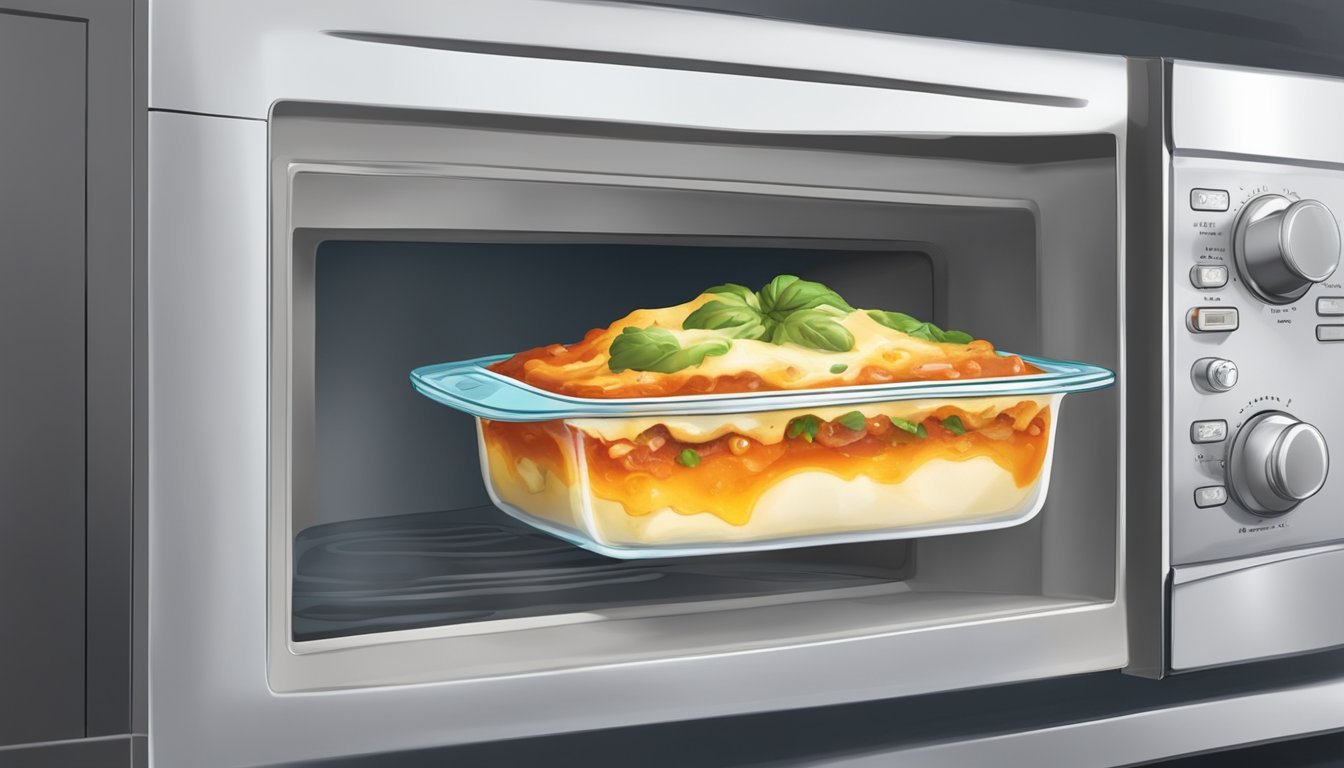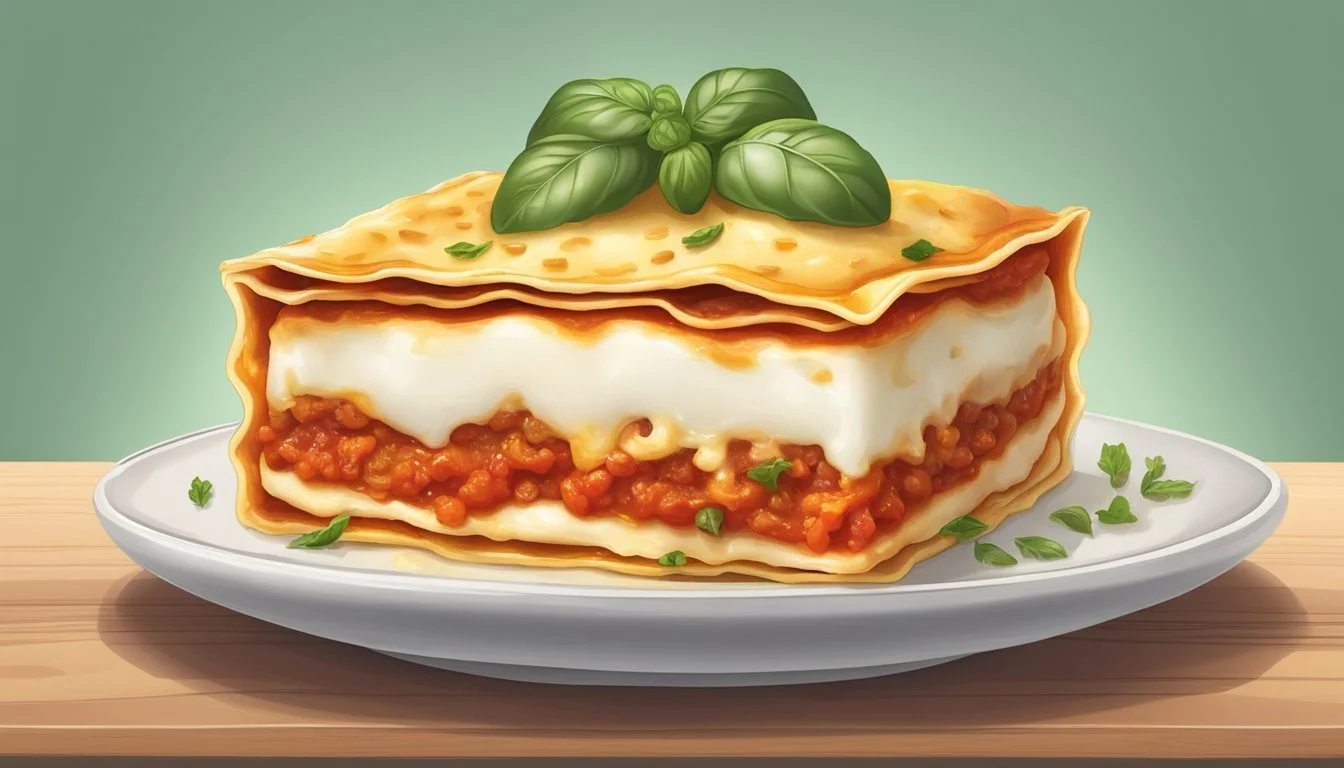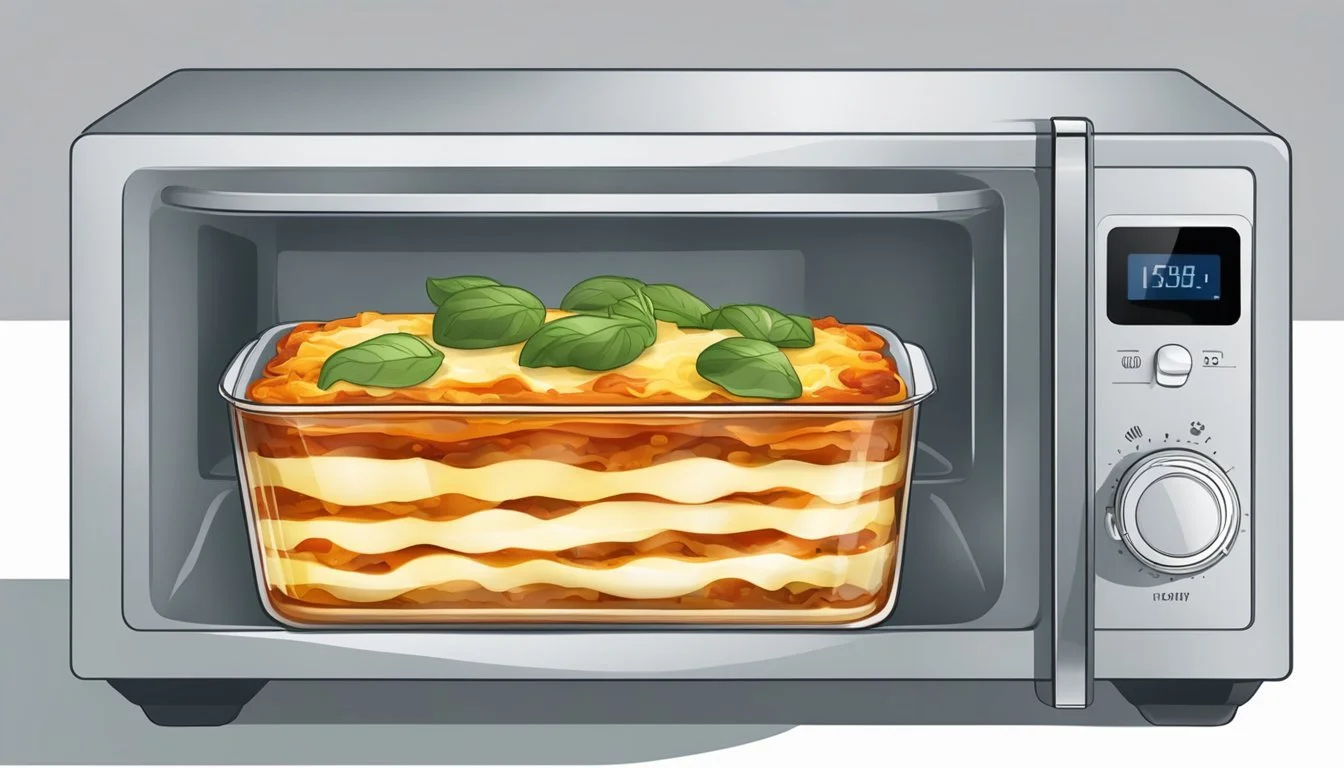Best Way to Reheat Vegetable Lasagna
Tips to Preserve the Cheese and Sauce
Reheating vegetable lasagna presents a common kitchen challenge: maintaining the dish’s alluring layers of molten cheese, robust sauce, and tender noodles. While a freshly baked lasagna offers a delightful blend of textures and flavors, ensuring the same quality in leftovers requires precise reheating methods. To achieve a second-day dish that rivals the initial serving, one must navigate the fine line between overheating, which can lead to dryness, and underheating, which leaves the center cold and the cheese unappetizingly solid.
A successful reheating technique not only warms the lasagna thoroughly but also revitalizes its saucy and cheesy character. It's critical to consider the tools available, as each kitchen appliance—the oven, microwave, skillet, or air fryer—can offer a pathway to a satisfactorily reheated lasagna. The key lies in the details: a dash of water can prevent dryness, incremental heating can preserve the quality, and covering the dish can evenly distribute heat.
The quest for the perfect reheating method calls for a balance of temperature control, timing, and moisture retention. By understanding the interactions between these factors, one can transform yesterday’s lasagna into a comforting meal that closely mirrors its initial cheesy, saucy perfection. Whether opting for a slow oven baking process or a quick microwave technique, careful execution can ensure the lasagna’s qualities are not just preserved but celebrated in the reheating process.
Understanding Lasagna Components
The success of reheating a vegetable lasagna hinges on the understanding of its components, each with its own response to heat. Proper heat application ensures that the cheese stays gooey and the sauce retains its moisture without overcooking the delicate pasta.
Why Layering Matters
Lasagna is typically composed of layers of pasta, cheese, and sauce that meld together during cooking. The layering ensures even distribution of flavors and textures with each bite. When reheating, it’s crucial to maintain this structure to avoid a dish that is either too dry or soggy. The pasta should be al dente, providing a firm structure, while the sauce should be sufficient to prevent drying out but not so much that it causes the layers to slide apart.
Selection of Cheeses
Choosing the right cheeses affects both the flavor and texture of the lasagna. Common choices for lasagna include:
Ricotta: Adds creaminess and moisture.
Mozzarella: Known for its melty and stringy quality when heated.
Parmesan: Provides a salty and sharp flavor enhancing contrast.
Cheeses with good meltability help in maintaining the lasagna’s creaminess upon reheating. However, they must also be able to withstand the reheating process without separating or becoming greasy.
Preparation Before Reheating
Proper initial steps are crucial to ensure that the vegetable lasagna reheats evenly while maintaining its cheesy, saucy quality. Attention to preheat settings and lasagna preparation will make a significant difference.
Preheat Your Tool
For an oven, it is recommended to set the temperature to 375°F (190°C). This gentle warming process helps in melting the cheese without drying out the lasagna. If using a microwave, one should avoid high settings. Instead, setting the microwave to medium ensures gradual heating. Individuals with a preference for crisp edges could opt for an air fryer, preheating to 350°F (175°C) for several minutes.
Prepping The Lasagna
Starting with the lasagna itself, if refrigerated, it should rest at room temperature for about 15 minutes before heating. This short rest permits an even reheat. For frozen lasagna, a complete thaw in the refrigerator overnight is advisable to avoid a cold center. Covering the lasagna with foil defends against moisture loss, especially in the oven. Lasagna pieces should be separated if necessary to allow for uniform heat distribution.
Reheating Methods
When reheating vegetable lasagna, maintaining its texture and flavor is crucial. The following methods are designed to preserve the lasagna's cheesiness and sauciness.
Oven Reheating Technique
Using the oven is ideal for keeping the lasagna moist. Preheat the oven to 350°F (175°C). Place the lasagna in an oven-safe dish, add a small amount of water for moisture, and cover it with foil to prevent drying out. Heat for approximately 20-30 minutes. For a bubbly top, remove the foil in the last 5 minutes.
Microwave Warming Strategy
The microwave is best for small portions. Place the lasagna on a microwave-safe plate, add a splash of water or extra sauce to prevent dryness, and cover. Use medium power setting and heat in one-minute increments, checking for an even temperature. Aim for an internal temperature of 165°F to ensure it's properly warmed.
Skillet Method for Stovetop
Reheating lasagna in a skillet retains moisture. In a non-stick skillet over medium heat, add the lasagna with a bit of water around the edges and cover with a lid. Allow it to steam for about 20 minutes, shaking occasionally, until it reaches 165°F. For crispness, let it cook uncovered at the end for a few minutes.
Additional Appliances
An air fryer or toaster oven can be effective alternatives. For the air fryer, preheat to 375°F, place the lasagna in the basket with foil underneath or in a small baking dish, and heat for about 10 minutes. Check the temperature frequently. The toaster oven follows a similar protocol to the regular oven method but may be quicker.
Reheating Large Batches
For larger portions, the oven method yields the best results. It uniformly heats multiple servings while keeping them moist. Make sure to cover with foil and extend the heating time as needed, keeping watch for the lasagna to reach the desired temperature.
Thawing and Reheating Frozen Lasagna
If starting straight from the freezer, it's important to first thaw the lasagna overnight in the refrigerator. Then, reheat using the preferred method, ensuring the lasagna is heated thoroughly and reaches a bubbling consistency without sacrificing its original flavor and cheesy layers.
Maintaining Quality and Texture
When reheating vegetable lasagna, it’s vital to preserve the meltiness of the cheese, maintain the integrity of the pasta, and manage moisture levels to avoid a dry or soggy dish.
Cheese Preservation
To prevent the cheese from drying out or burning, cover the lasagna with aluminum foil before placing it in the oven. The foil acts as a shield, distributing the heat evenly and locking in the cheese's moisture. For a delightful cheese texture that closely mimics that of a freshly baked lasagna, one may consider drizzling a small amount of olive oil over the cheese before covering the dish with foil. Heat at 350°F (180°C) for 20-25 minutes and remove the foil in the final 5 minutes if a golden top is desired.
Keeping the Pasta Perfect
Pasta layers in lasagna should remain tender and not overcook during reheating. To minimize further softening, ensure the lasagna is heated slowly and evenly. The foil cover also prevents the pasta edges from becoming too crisp or burned. The oven method is generally preferred over the microwave for keeping the pasta al dente, as the heat is more consistent.
Managing Moisture
Moisture loss can easily occur during reheating, which may lead to a less desirable texture. To combat this, one may add a splash of water—just enough to create steam—into the corner of the dish before covering it with foil. This trapped steam helps to keep the lasagna moist as it reheats, maintaining its saucy quality. However, be cautious not to add too much water, as this can cause the dish to become soggy.
Tips for a Cheesy and Saucy Result
Ensuring a vegetable lasagna retains its meltingly gooey cheese and rich sauce during reheating is essential for a delicious, as-fresh experience. The addition of extra cheese and sauce and a method for a crispy top are critical components.
Adding Extra Cheese and Sauce
To complement the inherent flavors and maintain moisture, extra cheese can be sprinkled on top of the lasagna before reheating. It’s recommended:
Type of Cheese: Choose a melty cheese, such as mozzarella or provolone, for the best result.
Sauce Application: Spoon a thin layer of the original or a high-quality marinara sauce over the lasagna. This compensates for any sauce absorbed by the noodles during the initial baking and refrigeration.
Achieving a Crispy Top
A crispy, golden top is quintessential to a great baked lasagna. The key to achieving this is through:
Oven Use: Set the oven to a high temperature briefly at the end of the reheating process. This helps crisp the top layer without overcooking the rest.
Broiler Option: Alternatively, a broiler can be used for the last few minutes. Watch closely as the cheese browns to avoid burning.
Employing these methods helps ensure that the reheated lasagna offers a delightful texture and depth of flavor, akin to its freshly baked counterpart.
Safely Storing Lasagna Leftovers
Proper storage is key to maintaining the quality and safety of lasagna leftovers. By following specific methods for refrigeration and freezing, one can ensure their lasagna retains its cheesy goodness and saucy appeal.
Storage Best Practices
To keep lasagna leftovers fresh and ready to reheat, they should be stored properly in the refrigerator within two hours of cooking. Leftovers need to be sealed tightly to prevent exposure to air, which can dry out the cheese and sauce. One can use plastic wrap or an aluminum foil to cover the lasagna tightly, or store it in an airtight container. A microwave-safe lid can be used if one plans to reheat the lasagna in the microwave directly from the refrigerator.
Do: Cover lasagna with plastic wrap or aluminum foil.
Don't: Leave lasagna uncovered in the refrigerator.
Freezing and Refrigeration Tips
Freezing lasagna can extend its shelf life, making it a convenient make-ahead meal. To freeze lasagna leftovers, they should be cooled down to room temperature to prevent condensation and ice crystal formation.
First, cut the leftover lasagna into portions for easy thawing.
Wrap each portion with plastic wrap and then with aluminum foil, or place in a freezer-safe container. The double layer helps prevent freezer burn.
Label the wrapped lasagna with the date, and store it in the freezer for up to three months.
When reheating, one doesn't need to thaw the lasagna; it can go straight from the freezer to the oven or microwave. However, if stored in the fridge, lasagna leftovers should be eaten within 3-5 days for best quality.
Do: Cool lasagna before freezing, wrap well, and label with the date.
Don't: Freeze lasagna that has been left out at room temperature for more than two hours.
Final Thoughts
When it comes to reheating vegetable lasagna, maintaining the quality of the dish is paramount. One aims for that perfectly bubbling top layer and a golden cheesy crust, reminiscent of when it was first baked. Achieving this involves a delicate balance of heat retention and moisture control.
The ideal method is using the oven, set at a moderate temperature of 350°F (180°C). Care should be taken to cover the lasagna with foil to prevent drying, especially since vegetable fillings are moisture-rich but sensitive to high heat. This method ensures even reheat and a moist interior. To add that much-desired crispness to the top:
Remove the foil cover during the last 5 minutes of reheating.
Monitor closely to avoid overcooking, which can compromise the lasagna’s texture and flavor.
It is crucial to let the lasagna rest for a brief period after heating. This allows the sauces to settle and the entire dish to achieve uniform warmth. Additionally, for those considering different reheating methods, consistency in outcome should always guide their choice. Reheating in a skillet or air fryer are alternatives, each with its nuances in terms of moisture control and heat distribution.
In summary, a reheated vegetable lasagna can be just as enticing as the freshly baked dish if managed with attention to temperature, timing, and technique. The key is in preserving the delicate balance between cheesiness and sauciness, ensuring each slice served is a delightful experience.





